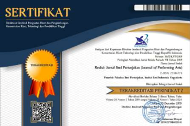Musik Iringan Tari Pencak Silat Rancak Takasima dalam Koreografi Idiom Baru
Abstract
The objective of this article is to elucidate the significance of music in complementing the choreography of the innovative Pencak Silat dance form known as Rancak Takasima. In the realm of dance performance, music plays a pivotal role as an accompaniment. While dance accompaniment music can exist independently, the reciprocal is not true – dance cannot be fully actualized without the support of accompanying music. Essentially, dance and music are inseparable counterparts, mutually enhancing and interdependent, akin to the interconnected sides of a coin. In the crafting of a dance performance, the presence of dance accompaniment, specifically in the form of musical compositions, serves as a crucial catalyst. This concept is referred to as external music, encompassing instruments like percussion, strings, and wind instruments employed as accompaniment in dance. In contrast, internal music entails sounds not generated by instrumental music but rather emanating from the dancer or performer, such as vocals, rhythmic footwork, finger snaps, chest and thigh percussion, hand claps, elbow taps, and the use of galembong (a patting technique on wide-legged pants). This research used a qualitative method with a dance ethnographic approach model. This technique research collected data through diverse methods such as observation, demonstration, interviews, and documentation during creating the creative process of choreographing the new idiom of Rancak Takasima. The development of dance accompaniment music and choreography unfolds gradually, originating from initially abstract ideas and taking visual form through Seni Pencak movements and the musicality crafted by the internal body's dancers themselves and using sound of 'serut bambu' props. The research outcomes showcase the Seni Pencak dance accompaniment music model as a valuable contribution to the evolution of Pencak Silat Nusantara dance. This particular dance accompaniment music model integrates seamlessly into the new idiom's choreography, featuring the distinctive ‘serut bambu’ property that generates the accompanying dance music. This research result conducted under Penelitian Terapan Jalur Hilirisasi (PTJH) scheme. For those interested in learning more, the dance accompaniment music and Seni Pencak choreography of Rancak Takasima can be easily accessed through the website https://www.dayaversapasua.tech.
Keywords
Full Text:
PDFReferences
Ediwar E, Minawati R, Yulika F, Hanefi H. Kajian Organologi Pembuatan Alat Musik Tradisi Saluang Darek Berbasis Teknologi Tradisional. Panggung [Internet]. 2019 Jun 1;29(2). Available from: https://jurnal.isbi.ac.id/index.php/panggung/article/view/905
Bastomi S. Apresisasi Kesenian Tradisional. Semarang: IKIP Semarang Press; 1988.
Saptono. Seni Pertunjukan Jemblung Pada Masyarakat Banyumas di Jawa Tengah: Perspektif Kajian Budaya. Denpasar: Udayana Press; 2011.
Yusmanto. Calung Kajian Tentang Identitas Kebudayaan Banyumas. Surakarta: ISI Surakarta; 2006. 226–227 p.
Caldwell MC. Dancing in silence in premodern Europe. postmedieval [Internet]. 2023 Sep 20;14(2–3):371–91. Available from: https://link.springer.com/10.1057/s41280-023-00268-0
Le N, Do T, Do K, Nguyen H, Tjiputra E, Tran QD, et al. Controllable Group Choreography Using Contrastive Diffusion. ACM Trans Graph [Internet]. 2023 Dec 5;42(6):1–14. Available from: https://dl.acm.org/doi/10.1145/3618356
Lytvynenko V, Perova G, Myroniuk N, Krys A, Koresandovych N, Morozov A. Analysis of Modern Trends in Contemporary Choreographic Art: The Challenges of Digitalization. J Curric Teach [Internet]. 2023 May 18;12(3):198. Available from: https://www.sciedupress.com/journal/index.php/jct/article/view/23539
Zhong Y, Zhang F, Demiris Y. Contrastive Self-Supervised Learning for Automated Multi-Modal Dance Performance Assessment. In: ICASSP 2023 - 2023 IEEE International Conference on Acoustics, Speech and Signal Processing (ICASSP) [Internet]. IEEE; 2023. p. 1–5. Available from: https://ieeexplore.ieee.org/document/10096824/
Hou Y, Yao H, Li H. Graph Convolutional GRU for Music-Oriented Dance Choreography Generation. In: 2023 IEEE International Conference on Multimedia and Expo (ICME) [Internet]. IEEE; 2023. p. 2111–6. Available from: https://ieeexplore.ieee.org/document/10219726/
Grover-Friedlander M. Listening to choreography. Choreographic Pract [Internet]. 2023 Jun 1;14(1):9–25. Available from: https://intellectdiscover.com/content/journals/10.1386/chor_00055_1
Zhou L. Research on the application of dance movement skill analysis in teaching in the context of artificial intelligence in universities. Appl Math Nonlinear Sci [Internet]. 2023 Jun 30; Available from: https://www.sciendo.com/article/10.2478/amns.2023.1.00482
Sumaryono. Seni Karawitan sebagai Iringan Tari, Studi Analisis Tata Hubungan. Yogyakarta; 2004.
Creswell JW. Research Design: Pendekatan Metode Kualitatif, Kuantitatif, dan Campuran. Yogyakarta: Pustaka Pelajar; 2017. 246 p.
Sugiyono. Metode Penelitian Kuantitatif, Kualitatif, dan Kombinasi (Mixed Methods).
Hajizar. Pengembangan Musik Tradisional Minangkabau dalam Era Globalisasi. Padang; 1994.
Murgiyanto S. Membaca Tari, Membaca Jawa (dan Indonesia). Surakarta: ISI Press Surakarta dan Komunitas SENREPITA Yogyakarta; 2018. 19 p.
Soerdarsono R. Pengantar Apresiasi Seni Tari. Jakarta: Balai Pustaka; 1992. 460 p.
Rai IW. Unsur Musikal dan Ekstra Musikal dalam Penciptaan Gending Iringan Tari Bali. Denpasar; 2004.
Rustiyanti S. Metode TaTuPa’ Tabuh Tubuh Padusi sebagai Musik Internal Visualisasi Koreografi NeoRandai. Resital J Seni Pertunjuk. 2019;20(3):161–74.
Netrirosa A. Musik Tradisional Minangkabau Dari Masa Kemasa. Universitas Sumatera Utara; 2003.
Rustiyanti S. Musik Internal dan Eksternal dalam Kesenian Randai. Resital J Seni Pertunjuk. 2014;15(2):152–62.
Clark A. Analysis, Measurement and Modelling of Jitter. Geneva: International Telecommunication Union;
Rustiyanti S. Aluang Bunian Karawitan Minangkabau dalam Pamenan Anak Nagari dari Penyajian Bagurau ke Presentasi Estetik. Resital J Seni Pertunjuk. 16AD;2:104–15.
DeVale, I Wayan Dibia SC. Sekar Anyar: An Exploration of Meaning in Balinese “gamelan". World Music. 1991;33(1):5–51.
Gunawan A. Makna Simbolik Musik Daak Maraaq dan Daak Hudoq dalam Upacara Hudoq Bahau di Samarinda Kalimantan Timur. Resital J Seni Pertunjuk. 2020;21(2):1–14.
Rembang. IN. Hasil Pendokumentasian Notasi Gending-Gending Lelambatan klasik pegongan daerah bali. Jakarta: Departemen Pendidikan dan Kebudayaan; 1985.
Boden MA. Creativity and Art. New York: Oxford University; 2011.
Rustiyanti S, Listiani W, Ema M.N A. Minang Folklore of Pencak Arts to Strengthen Mental Health in Indonesian Muslim Society. Mudra J Seni Budaya [Internet]. 2023 Mar 27;38(2):119–216. Available from: https://jurnal.isi-dps.ac.id/index.php/mudra/article/view/2342
Piliang. YA. Dunia Yang Berlari. Yogyakarta: Aurora (CV Cantrik Pustaka); 2017.
Marianto D. Teori Quantum: Untuk Mengkaji Fenomena Seni. Yogyakarta: BP ISI Yogyakarta;
Raharja B. Musik Iringan Drama Tari Pengembaraan Panji Inukertapati Bermisi Perdamaian dan Toleransi. Resital J Seni Pertunjuk. 2019;20(1):1–11.
DOI: https://doi.org/10.24821/resital.v25i1.11998
Refbacks
- There are currently no refbacks.
This work is licensed under a Creative Commons Attribution 4.0 International License.



